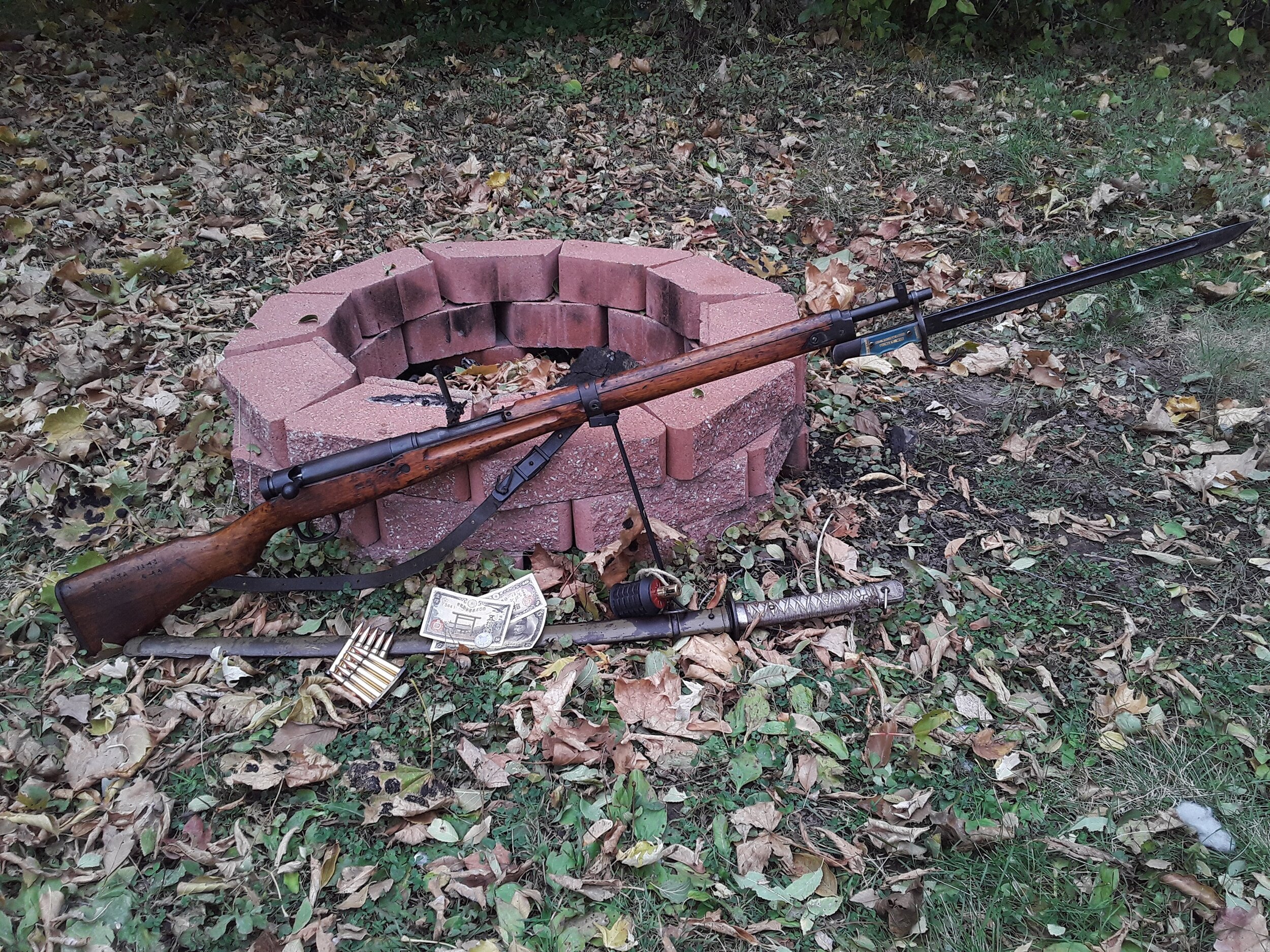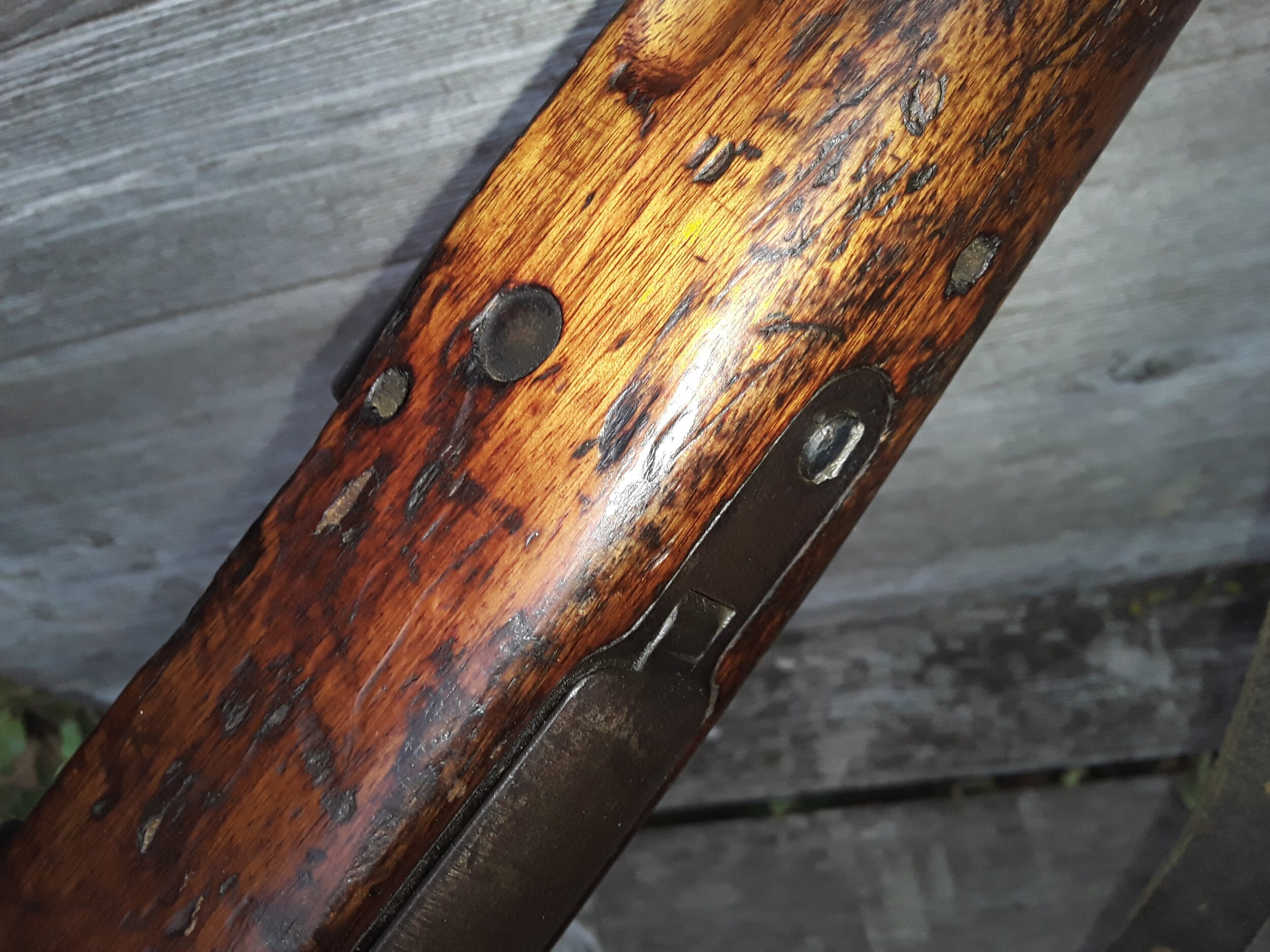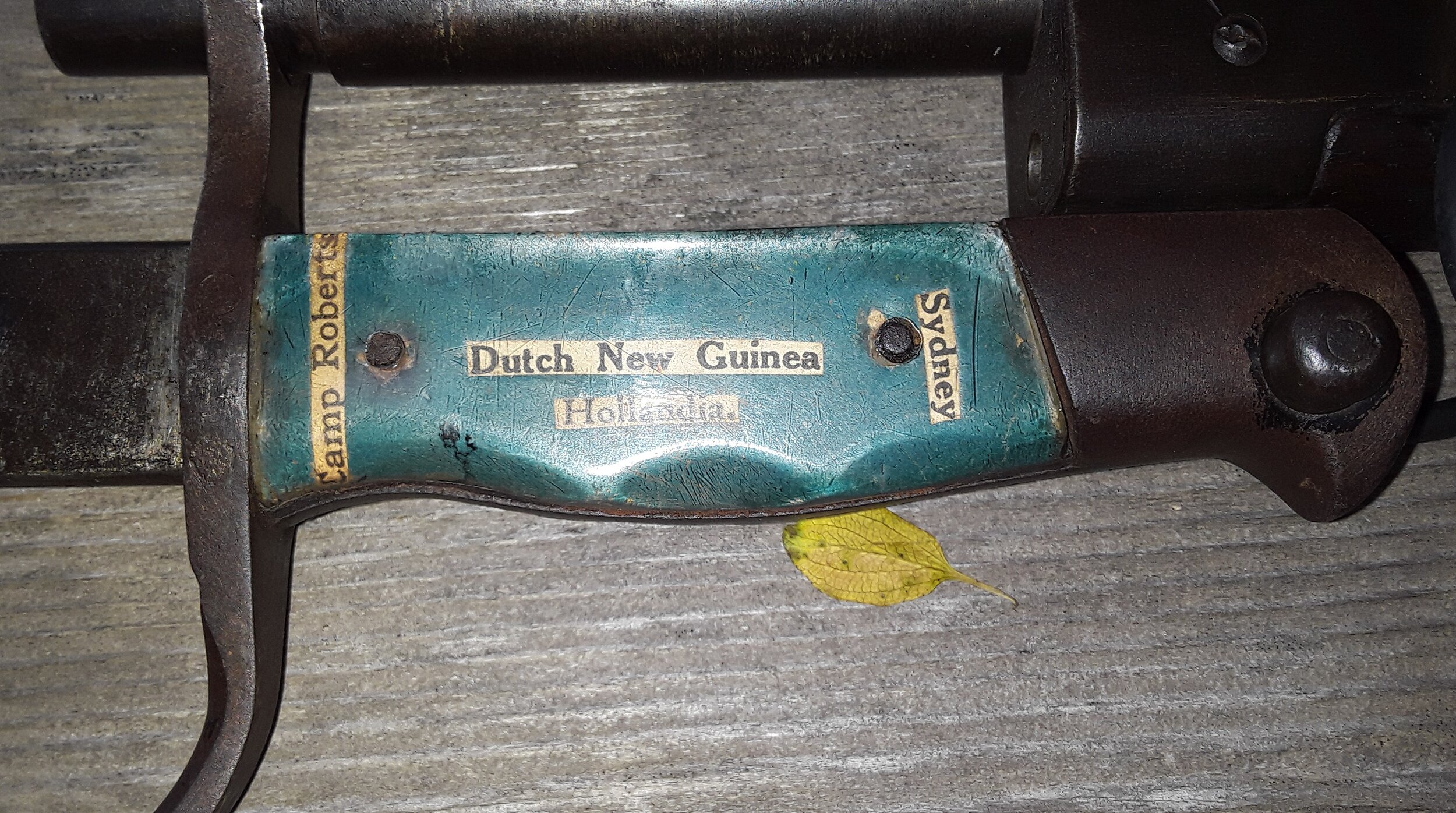Type 99 Arisaka
The 7.7mm Type 99 short rifle was adopted by the Imperial Japanese Military in 1939, just as the world toppled into war once again. Having already been at war in China for two years, Japan had moved to replace the aging Type 38 rifle.
The Type 99 Arisaka, shown with Type 30 bayonet fixed, ammunition, wartime Japanese Yen, a repro Type 97 hand grenade and a Type 95 Shin Gunto (NCO sword)
For November of 2020 this is the Japanese Type 99 rifle, commonly known as the Arisaka Type 99 in the United States. The Empire of Japan had been at war in China since 1937, and in that conflict it had been noted that the 7.7mm cartridge used by Japanese machine guns , as well as the 7.92mm Mauser cartridge common with Chinese troops, was more effective than the 6.5mm used the IJA Type 38 rifles, and accordingly a requirement for a new rifle chambered in 7.7mm was issued. The result would eventually be a fairly modern short rifle that used the same basic action as the Type 38, which was already noted for its simplicity and durability, mated to a new rimless 7.7mm cartridge and several other features that made the rifle a general step above the older design. In addition to the new cartridge the rifle featured improved sights, an improved stock drainage system, reinforced bayonet lug (still accepting the Type 30 bayonet of most Japanese designs), side mounted sling swivels, as well as a new monopod to facilitate accurate fire.
Two charger clips loaded with 7.7x58mm ammunition. Pictured are original clips loaded with modern Steinel soft points.
Like the Type 38 and its derivatives, the Type 99 was to be produced by various Japanese government arsenals. Following the Great Kanto Earthquake of 1923 the Japanese had dispersed their arms industry, as their only major arsenal up to that point, at Koishikawa, was destroyed, leading to several government arms factories being created around the country, the largest being Kokura and Nagoya. Production of the Type 99 began around 1940, with a long rifle as well as the short rifle entering service. The long rifle was quickly deemed redundant, and from 1941 onward only short rifles were produced.
The Chysantemum, or mon, commonly known as a “mum” to US collectors, was the emblem of the Emperor and adorned the chamber of almost all Type 99 rifles. Many rifles had this emblem defaced at the time of surrender. Below is the designation 九九式 (Kyukyu-shiki, 9-9-Type).
Despite its common name, Nariakira Arisaka only designed the original Type 30 rifle in the 1899, with further development of the Type 38 and later Type 99 by prolific Japanese arms designer Kijiro Nambu. Several of the unique features of the Type 38 were carried over and improved for the Type 99. The sliding dust cover of the older rifle was retained, although slightly simplified into a one-piece design. The rifle also had inlets in the stock to allow water to drain out if the rifle became submerged, but with an improved design with dual drainage holes as opposed to the large single indent on the side seen in the Type 38. The Type 99 also retained the extremely simple mechanism of its predecessor, with only four components to it’s bolt, and simple one-motion disassembly. The action was also remarkably strong, with Mauser style dual front locking lugs along with the bolt handle serving as a redundant third lug. The distinctive flat safety catch also served as a large gas shield, working with the hole on top of the chamber to protect the user from failed cartridges. Lastly, the rifle retained the Mauser style long claw extractor, leading to smooth and reliable feeding and extraction. Another retention from the older design was the two piece stock, which was horizontally spliced in the butt to compensate for the thinner trees endemic to Japan and Asia, allowing more efficient construction of stocks while also adding strength.
The action with the dust cover removed, the Mauser heritage of the design on full display
The Type 99 had more new features than it’s caliber, however; including redesigned rear sights, a reinforced front barrel band, and a folding monopod. The front sight of the weapon was identical to later production Type 38s, with a basic blade protected by two posts, but the rear sight, while retaining the ladder of the previous design, now featured an aperture in place of the older v-notch. The rear sight, when folded, presented a battle sight set for 300 meters, and can be folded up to a ladder graduated from 300 to 1500 meters. When the ladder has been set to a long range, an emergency notch sight is located in the bottom of the ladder set to 300 meters, providing an emergency close range battlesight. A unique feature of the Type 99 are the extendable calipers on either side of the ladder, intended to engage aircraft. While often ridiculed, these were intended for use against the primitive aircraft in use by China, allowing columns of Japanese infantry to compensate for a lack of mobile anti-aircraft guns. Despite this, by the time the rifle was entering service in significant numbers the United States had entered the war, with modern aircraft with speed and armor protection that made the idea of them being shot down by rifle fire ludicrous.
The rear sight ladder of the Type 99, with the anti-aircraft calipers extended
The front barrel band was also reinforced, a helpful choice considering the Japanese’ emphasis on bayonet combat, as was the choice of retaining the Type 30 Bayonet, at least in regard to the logistical issues that could arise from a new design. The folding wire monopod was less effective, being a rather flimsy addition that was too narrow to serve as a superior firing platform to simply bracing the rifle, as well as increasing weight. Both this and the dust cover are often quoted as being discarded by Japanese soldiers, the former due to its flimsiness and the latter due to the noise it generated when cycling. The evidence suggests, however, that the dust covers were never discarded by Japanese soldiers, although later in the war they were omitted from new rifles as part of a series of design changes to simplify production. It is much more likely that they were discarded by US troops returning with trophies after the war, as the covers fall off when the bolt is removed, and even if they did not they require some effort to properly align when reinserting the bolt, and may have been discarded simple to eliminate what appeared to be a useless, rattling part. The monopods are a slightly harder question, as it is possible that they were not discarded by soldiers but by GIs after the war, but it is also possible that the thin wire monopods were prone to bending and damage, and were thus removed by the Japanese, I have not been able to find solid information on that front.
The drainage holes of the Type 99, located on the side of the rifle just behind the recoil lug, as well as on the bottom of the rifle just ahead of the action screw
During the war the Type 99 would see a series of simplifications intended to preserve scarce raw materials as well as to increase production as the Imperial Military faced increasing attrition against the United States, Commonwealth and China on multiple islands and fronts. The stock was simplified, additional features like the AA sights, monopod, dust cover and chromed bores were omitted, among others. Late war examples, commonly called “Last Ditch” by American collectors, typically feature non-adjustable rear aperture sights, crude dowel shaped bolt handles and even wooden buttplates held on with nails, among other simplifications. The Type 99 of 1945 was a far cry from the beautiful rifle that was originally designed.
The butt of the rifle, marked by the US soldier who captured it with the locations and dates of two major battles in the Pacific. The characteristic Japanese stock splice is visible here as well
The Type 99 was, like all Japanese small arms produced by government arsenals, with rifles produced in series of 100,000 rifles serial numbered from 0 to 99,999 prefixed by a small Japanese character. The example pictured today was made by the Nagoya arsenal, and is a second series rifle, likely produced in 1941. The rifle retains the Imperial Chrysantemum, and is marked on the butt with “Tarawa 11-43” and “Saipan 6-44”, two famous engagements of the war, that the soldier who brought the rifle back may have participated in.
The long Type 30 bayonet was essentially unchanged since adoption with the Type 30 rifle at the close of the nineteenth century
The rifle did not have a dust cover or monopod when I purchased it, but I was fortunate enough to locate an original dust cover earlier this year, and also purchased a reproduction monopod, serving as a placeholder until I acquire an original. The rifle had characteristic marring on the metal and wood to confirm they were both originally present on the it. The bayonet that came with the rifle features clear plexiglass grip panels, covering the name of the man who brought it back from the war, along with a list of locations presumably visited by him during the war. Lastly, despite it’s age, the sling is not original to the rifle, although it has signs of being present there for a long time.
The custom grip panel of the bayonet, identifying it as belonging to Sgt. William Pelto of Hurley, Wisconsin
The opposite side, with more locations
UPDATE
The author was contacted by the family of Sgt. Pelto, and the bayonet is now back in their possession!
I have always enjoyed the Type 99, finding it a light, handy weapon with good accuracy. The main issue with it is has always been the difficulty involved in finding 7.7mm ammunition to feed it. This problem has, thankfully, been somewhat abated by Steinel Ammunition, who have begun production of the caliber. I find the sights fairly easy to use, although still inferior to the rear mounted apertures seen on US designs of the period. In addition, the simplicity of the design combines to make this, in my opinion, one of the best bolt action service rifles ever adopted, and certainly undeserving of the poor reputation that has dogged them since the war. This reputation is primarily a residual effect of wartime propaganda, as well as unfortunate issues involving catastrophic failures resulting from use of service ammunition in similar looking training rifles intended only for use with blanks.
Imperial Japanese Army troops surrender their Type 99 rifles to US personnel
Observed Values and Frequency
Updated: February, 2024
AVERAGE VALUE (USD): $500 - $750
FREQUENCY: Uncommon
COLLECTOR’S NOTES: Collectors place a high value on the intact Chrysanthemum seal, as well as the presence of accoutrements such as the dust cover and cleaning rod.
Signifiant variation exists as the war progressed, althiough it is generally accepted that the “Last Ditch” variety starts when the rear sights were changed to a fixed type.











